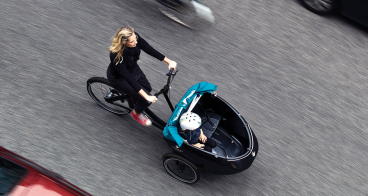Is gender part of your mobility lens? | Keynote by Marianne Weinreich
Transport and mobility are not gender neutral. One of the core reasons for that is that the structural gender differences that still remaining in society affect and influence our transport options, needs and mobility patterns. Marianne Weinreich reflects on the status quo in urban planning.
As International Transport has concluded “gender is one of the most robust determinants of transport choice”. The fact that women are still responsible for 75% of the unpaid care work in the world, that women to a greater extent than men work part time, and that women generally earn less than men, and have the majority of the paternity leave etc. means that women to a greater extent than men travel shorter distances but make several, shorter trips (trip chaining) while carrying groceries and/or accompanying children or older family members. Men are on the other hand more likely to have travel longer, but alone commuting to and from work.
The existing international research also shows when it comes to transport modes used women walk and use public transport (especially buses) more than men. Men are on the other hand more likely to have a driver’s license and access to a car meaning that men drive more than women.
Men generally also cycle more than women – except in cities and countries like Denmark and the Netherlands where cycling infrastructure is safe and coherent. Here we see that women and men cycle equally much. According to Dr Jan Garrard (City Cycling, MIT Press Ltd 2012), the share of women cycling is an indicator for how safe a city is for cycling. Research shows that women are more averse to risk than men in general and in cycling that manifest in a demand for safe cycling infrastructure as a prerequisite for cycling.
Men also use new mobility services like carsharing, ridesharing, and e-scooters more than women. Data and research show that access, price, safety concerns and challenges bringing children or travelling with groceries and bags are some of the explanations for these differences.
When it comes to the experience of travelling women worry more than men about which routes to take and what time they travel as concerns for personal safety, catcalling, harassment or assault is part of many women’s daily lives travelling – especially walking and using public transport at night.
Gender mainstreaming as a strategic approach
But even so gender mainstreaming is not systematically included in transport and mobility planning and projects. In addition, gender disaggregated data on travel behaviour, trips, needs and concerns in mobility is often either not collected or not analysed systematically. In a sector with 78% men this has created an unconscious bias towards men in transport and mobility planning and design.
Research shows that when gender is not explicitly part of the planning process, the solutions are most likely to primarily benefit men. Whereas the explicit consideration of gender throughout the process of planning, design, implementation, monitoring, and evaluation is more likely to create more gender equal solutions.
Only by understanding the needs of women can we create truly equal transport systems and mobility services. In the transport sector, we need to include gender mainstreaming as a strategic approach and implement targeted measures to include women on all levels. A better gender balance on all levels of the transport sector is a prerequisite for more equal, safe, inclusive, and sustainable transport and mobility.
Recommendations
In March 2021 Ramboll published the report Gender and (smart) mobility where we have collected data and research on gender and mobility from seven capitals and countries. In the report we propose 25 recommendations to create more equal and sustainable mobility for all.
Policy and strategies
- Include gender mainstreaming as a strategic approach for assessing the implications of any planned action, legislation, policy or programmes for both women and men in all areas and at all levels.
- Identify and include a broad spectrum of stakeholders when developing policies and strategies and make sure different needs are represented.
- Develop an EDI policy (Equality, Diversity, and Inclusion) and make sure it’s reflected in all practices and processes e.g. procurement, planning and design.
Data collection and analysis
- Include collection and analysis of gender segregated data in planning and design.
- Review existing data collection methodologies and asses if they properly identify and include gender differences in travel patterns, mode choices and trip purposes.
- Analyse the collected data with a gendered lens and incorporate the findings in projects and solutions.
- Complement quantitative methods of data collection with qualitative methods and recognise the value of qualitative data.
- Include gender and social impact assessments (SIA) as part of the planning process just like other studies of traffic or environmental effects.
- Include gender impacts in cost-benefit analysis.
- Carry out feasibility studies before and post-feasibility studies after projects to study who the users are, how they are using the facilities and why other groups are not users and how to improve.
- Make sure data collection is transparent and fulfilling gaps.
Planning and design
- Study, analyse and include user-needs, challenges and concerns in planning and service-design. Only by understanding the needs of the citizens can we create truly equal transport systems and mobility services.
- Provide the right services, at the right time at the right place for the right users.
Safety and security
- Don’t victimise women, but include safety and security in the design of the solutions – not as an addon to cater for women as a group with special needs, but as an integral part of the project or solution.
- Prioritise, provide, and maintain basic infrastructure for walking and cycling and secure public transport.
Diversity and inclusion
- Study why women do not find the transport and engineering sector attractive.
- Implement specific and targeted measures of change to accommodate and include women on all levels in the transport sector. A better gender balance on all levels of the transport sector is a prerequisite for a more equal, safe and inclusive transport and mobility.
- Include gender differences, data gaps and unconscious bias in the curriculum for engineering and transport planner students.
- Be conscious about the gender balance when putting together transport project teams, groups, committees, advisory boards and the like
- Keep an open mind, listen, learn, and change procedures and practices when needed.
Fact box
In 1997 the United Nations Economic and Social Council (ECOSOC) endorsed “Gender mainstreaming” as a critical and strategic approach for achieving gender equality. The concept of Gender mainstreaming is defined as follows: “Mainstreaming a gender perspective is the process of assessing the implications for women and men of any planned action, including legislation, policies or programmes, in all areas and at all levels. It is a strategy for making women’s as well as men’s concerns and experiences an integral dimension of the design, implementation, monitoring and evaluation of policies and programmes in all political, economic and societal spheres so that women and men benefit equally and inequality is not perpetuated. The ultimate goal is to achieve gender equality.” (UN: Gender mainstreaming: A global strategy for achieving Gender equality & the empowerment of women and girls. UN Women 2014 UN: GENDER MAINSTREAMING. Extract from REPORT OF THE ECONOMIC AND SOCIAL COUNCIL FOR 1997 (A/52/3, 18 September 1997)).
By Marianne Weinreich, Market Manager, Ramboll Smart Mobility
Marianne Weinreich holds a Master in Scandinavian literature and language and World History, but for more than 20 years she has advised cities about sustainable mobility policy and promotion and mobility management. She is an expert in cycling policy and promotion. The last 4 years she has been Market Manager in Ramboll’s Smart Mobility division where she is advising cities and leading the thought leadership programme. As part of that, she was lead author of the report “Gender and (smart) mobility” published in March 2021 and the new one “Walking and cycling data – practice, challenges, needs and gaps”. She is also co-founder and Chair of the Cycling Embassy of Denmark and an experienced speaker at and moderator of cycling and mobility webinars and conferences around the world.
Access the full report Gender and (smart) mobility or download it in the shared files section below the video.
Updated on 17 March 2023.






